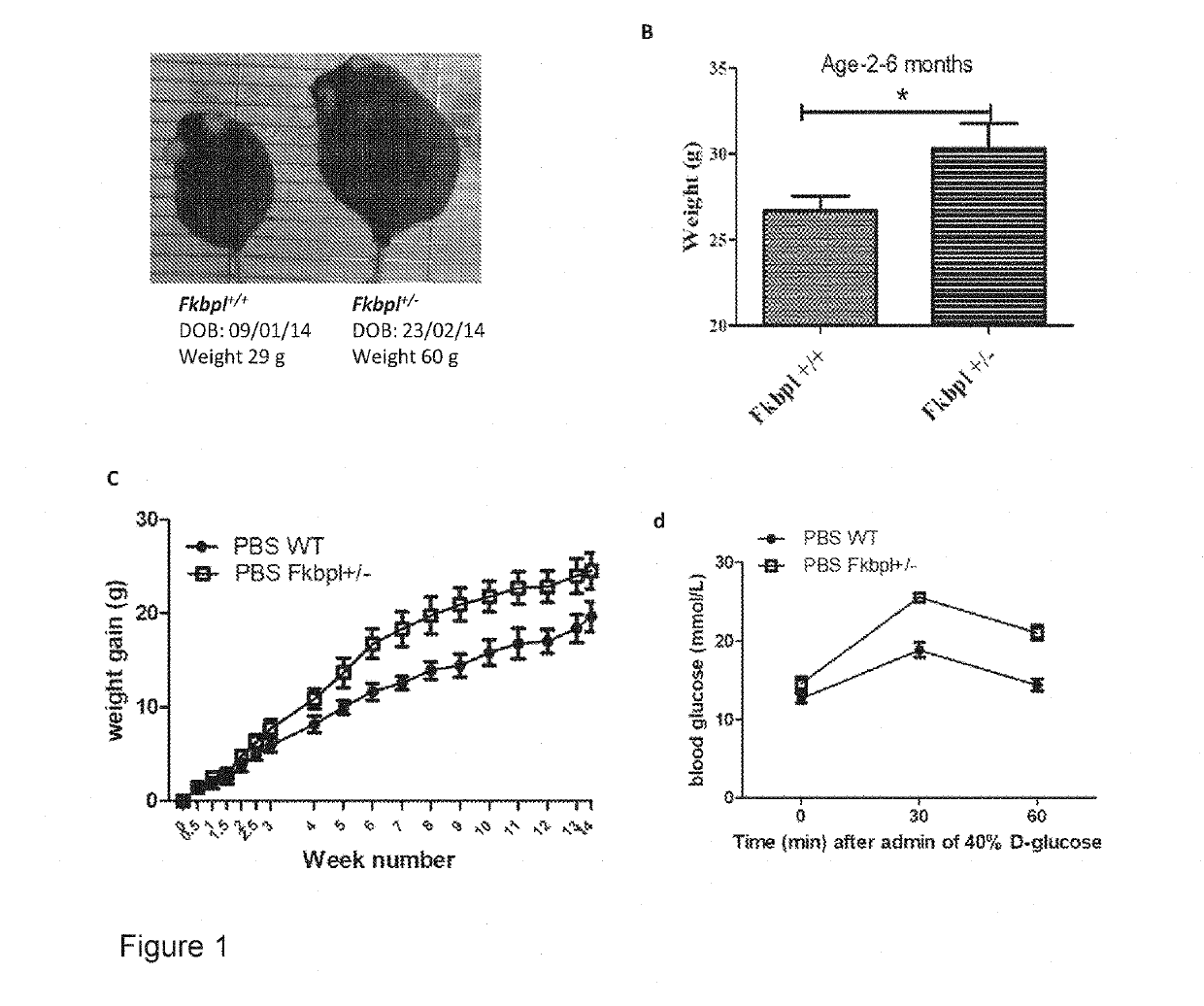Use of fkbp-l polypeptides and nucleic acids for the treatment of obesity
a technology of fkbp-l and polypeptides, which is applied in the direction of peptide/protein ingredients, drug compositions, metabolic disorders, etc., can solve the problems of discrimination, psychological problems, and substantial increase in morbidity and mortality, and achieve the effect of increasing the expression level or activity of fkbp-l polypeptides
- Summary
- Abstract
- Description
- Claims
- Application Information
AI Technical Summary
Benefits of technology
Problems solved by technology
Method used
Image
Examples
example 1
[0159]Comparison of Weight Gain and Increased Adiposity in Fkbpl+ / − Mice with their Wild-Type (WT) Littermates, Fkbpl+ / + on a Normal and on a High Fat Diet.
[0160]To generate FKBP-L+ / − mice, C57BL / 6N mice were used for microinjection of the Fkbpl-targeted embryonic stem cell line, JM8A3. The vector, ES cell(s), and / or mouse strain used was generated by the trans-NIH Knock-Out Mouse Project (KOMP) and obtained from the KOMP Repository (www.komp.org). ES cells were obtained from KOMP (USA); exon 2 of Fkbpl was deleted. (Fkbpl—IKMC Project: 41363; Clone number: EPD0466_1_C01), obtained from KOMP (UC Davis Repository, USA) were microinjected at MRC Harwell (UK) into C57BL / 6N mice mouse blastocysts to establish germ-line transmission. The resulting chimeric offspring were bred with C57BL mice to obtain germline transmission of the mutated Fkbpl allele and obtain Fkbpl+ / neo mice. Subsequently, Fkbpl+ / neo mice were crossed with B6N-TgN (ACTB-Cre)3Mrt / H mice (βactin-Cre Tg) to ubiquitously r...
example 2
Oral Glucose Tolerance Test (OGTT)
[0166]An OGTT was performed by fasting the mice for 4 h, taking baseline blood glucose, administering 40% D-glucose, and recording two further blood glucose readings at 30 and 60 min. As illustrated in FIG. 1D, Fkbpl+ / − mice has demonstrated a reduced glucose tolerance compared to wild-type Fkbpl+ / + mice.
[0167]The results of this experiment indicate that a deficiency in FKBP-L is associated with the development of diabetes mellitus type 2.
example 3
Weight Gain and Glucose Intolerance Improved Following Administration of FKBP-L's Peptide Derivative ALM201
[0168]For the high fat diet study, 40 age and sex matched mice were chosen with an age range of 6-10 weeks at the experimental start date. Mice were randomised into four groups: PBS Fkbpl+ / −, PBS Fkbpl+ / +, ALM201 Fkbpl+ / − and ALM201 Fkbpl+ / +. Power calculations were utilised to predict the number of mice needed to show statistical significance. Taking group 1 mean weight to be 25 g and group 2 mean weight to be 45 g, with a standard deviation of 13 gives a sample size of eight mice per group when powered to 0.8, with α=0.05. 10 mice per treatment group were used. All mice were weighed at experimental start date, biweekly for the first three weeks to ensure health, and weekly thereafter. Mice were solely fed a high fat diet comprising 60% fat (Cat no. F3282, Dates and, USA). Food provided was weighed biweekly for three weeks, then weekly, to ensure equal food provisions between ...
PUM
| Property | Measurement | Unit |
|---|---|---|
| waist circumferences | aaaaa | aaaaa |
| waist circumferences | aaaaa | aaaaa |
| pH | aaaaa | aaaaa |
Abstract
Description
Claims
Application Information
 Login to View More
Login to View More - R&D
- Intellectual Property
- Life Sciences
- Materials
- Tech Scout
- Unparalleled Data Quality
- Higher Quality Content
- 60% Fewer Hallucinations
Browse by: Latest US Patents, China's latest patents, Technical Efficacy Thesaurus, Application Domain, Technology Topic, Popular Technical Reports.
© 2025 PatSnap. All rights reserved.Legal|Privacy policy|Modern Slavery Act Transparency Statement|Sitemap|About US| Contact US: help@patsnap.com



